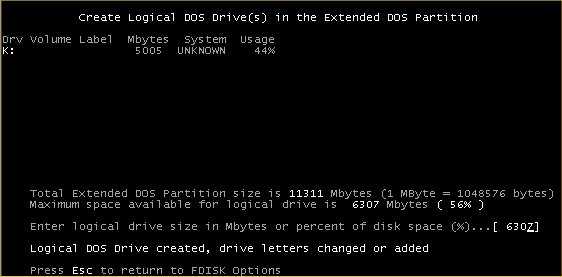Formatting a Disk under DOS
This page shows you how to format a disk drive into one primary partition and one extended partition containing a logical drive under DOS or under a DOS box in Windows 95 (OSR2), 98 or ME. Windows version 1 only supports partitions up to 2GB and is not covered here.
If you are formatting a drive for Windows 95 please note that large disk mode should not be enabled or FDisk will create FAT32 partitions.
Instructions
- Boot into DOS or start a DOS session from Windows.
- Enter the command FDISK them press ENTER.

- If you are creating a primary partition for Windows 95 release 1 do not enter N in the above menu.
- The default disk is disk 1, if you are setting up partitions on a new disk select option 5 Change current fixed disk drive.

- A new disk is identified by the free space column, in the example below this is disk 3, enter 3 then press Enter.

- The Current fixed disk drive is now 3, select option 1 to create a DOS partition.

- Select option 1: Create Primary DOS Partition.

-
On the next form enter N to Use maximum space, then enter the size of the primary partition on the following form, below we have entered 10240 for 10GB.

-
Once created repeat the process but this time select Create Extended DOS Partition and use the remaining space. In this partition create one or more logical drives.

-
Once the logical drives have been created you are required to re-boot your PC.
After re-booting your PC.
Back to:
Part 2 of Using a USB or FireWire Drive for Disaster Recovery.
Part 1 of Using a USB or FireWire Drive for Disaster Recovery.


